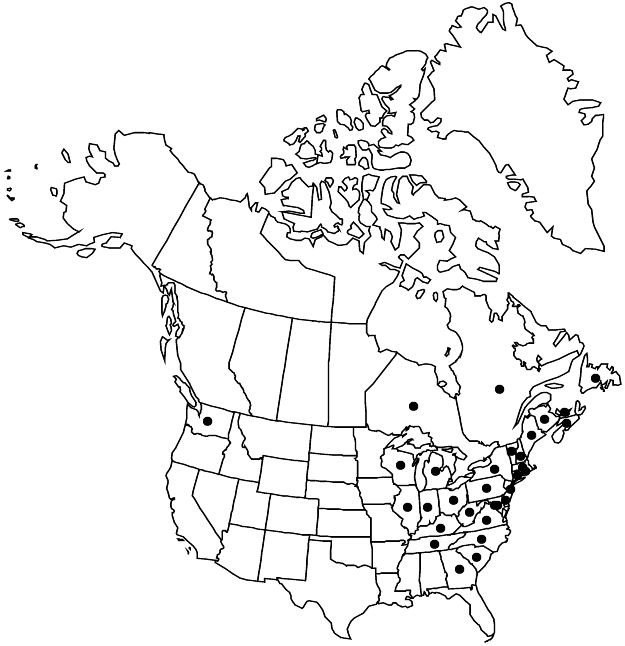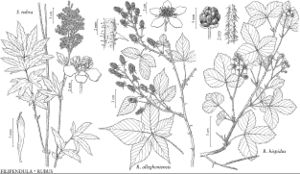Rubus hispidus
Sp. Pl. 1: 493. 1753.
Shrubs, sometimes herblike, to 2 dm, armed. Stems biennial, creeping, tip-rooting, flowering branches often erect, glabrous or sparsely hairy, sparsely to densely short- to long-stipitate-glandular, rarely eglandular, not pruinose; prickles sparse to dense, erect to retrorse, weak, slender, 1–3(–5) mm, narrow-based; bristles sparse to dense, erect or retrorse, narrow, flexible and weak, not gland-tipped. Leaves persistent, ternate or, rarely, palmately compound, lustrous; stipules linear to narrowly lanceolate, (2–)5–15(–20) mm; leaflets 3(–5), terminal obovate to suborbiculate, 1.7–6.5 × 1–5.2 cm, base cuneate to rounded, unlobed, margins moderately to coarsely doubly serrate, apex acute to rounded, abaxial surfaces with bristles on midvein or unarmed, glabrous or sparsely hairy, sparsely to densely short-stipitate-glandular along largest veins. Inflorescences terminal on short shoots, usually appearing axillary, 1–7(–10)-flowered, racemiform. Pedicels unarmed or bristles moderate to sometimes dense, erect to retrorse, moderately to densely hairy, sparsely to densely short- to long-stipitate-glandular. Flowers bisexual; petals white, obovate to oblanceolate, 6–10 mm; filaments filiform; ovaries glabrous. Fruits black, globose to cylindric, to 1 cm; drupelets (5–)10–15(–20), strongly coherent, separating with torus attached. 2n = 14, 21, 28, 35, 56.
Phenology: Flowering May–Jul(–Aug).
Habitat: Moist to wet woodlands, meadows, openings, bogs, fens, disturbed areas, wet to dry soil
Elevation: 0–1500 m
Distribution

N.B., Nfld. and Labr. (Nfld.), N.S., Ont., P.E.I., Que., Conn., Del., D.C., Ga., Ill., Ind., Ky., Maine, Md., Mass., Mich., N.H., N.J., N.Y., N.C., Ohio, Pa., R.I., S.C., Tenn., Vt., Va., Wash., W.Va., Wis.
Discussion
Rubus hispidus is identified mostly by its creeping primocanes with somewhat lustrous, coriaceous, and relatively small leaves that persist for nearly a year, and an armature of stiff hairs or, rarely, weak, slender prickles. Plants with few persistent leaves may be evidence of introgression with R. flagellaris or R. setosus. Hybrids with R. cuneifolius have been seen around abandoned commercial cranberry bogs in New Jersey (G. Moore, pers. obs.). The superficially similar R. caesius differs from R. hispidus in its pruinose stems, deciduous and non-lustrous leaves, and pruinose fruit.
Rubus hispidus is introduced in southwestern Washington State.
The following nothospecies names are based on putative hybrids involving Rubus hispidus and: R. canadensis (R. ×novanglicus L. H. Bailey); R. flagellaris (R. ×ambigens Fernald, R. ×distinctus L. H. Bailey, R. ×elongatus Brainerd & Peitersen [not R. elongatus Smith], R. ×emeritus L. H. Bailey, R. ×furtivus L. H. Bailey, R. ×kalamazoensis L. H. Bailey, R. ×permixtus Blanchard, R. ×rosendahlii L. H. Bailey, R. ×segnis L. H. Bailey, R. ×varus L. H. Bailey, R. ×vigoratus L. H. Bailey); R. setosus (R. ×adjacens Fernald, R. ×grandidens L. H. Bailey, R. ×harmonicus L. H. Bailey, R. ×jacens Blanchard, R. ×parlinii L. H. Bailey, R. ×spiculosus Fernald, R. ×tardatus Blanchard, R. ×tholiformis Fernald, R. ×trifrons Blanchard, R. ×zaplutus L. H. Bailey).
Selected References
None.
